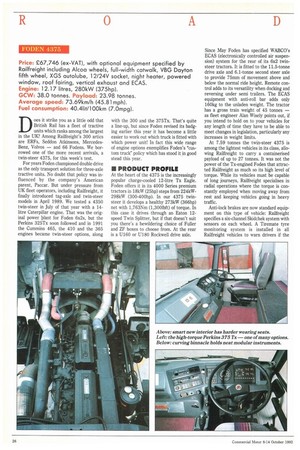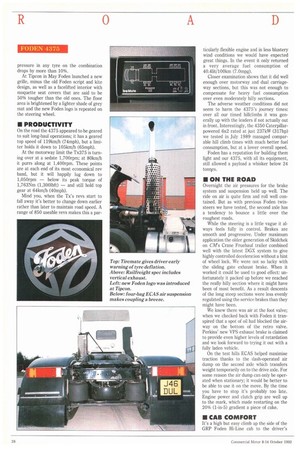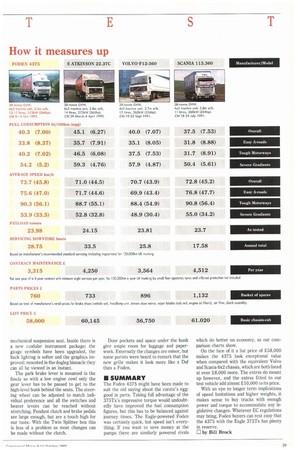D oes it strike you as a little odd that British
Page 28

Page 30

Page 31

If you've noticed an error in this article please click here to report it so we can fix it.
Rail has a fleet of tractive units which ranks among the largest in the UK? Among Raillreight's 300 attics are ERFs, Seddon Atkinsons, MercedesBenz, Volvos — and 66 Fodens. We borrowed one of the more recent arrivals, a twin-steer 4375, for this week's test.
For years Foden championed double drive as the only transport solution for three-axle tractive units. No doubt that policy was influenced by the company's American parent, Paccar. But under pressure from UK fleet operators, including Railfreight, it finally introduced tag-axle and twin-steer models in April 1989. We tested a 4350 twin-steer in July of that year with a 14litre Caterpillar engine. That was the original power Plant for Foden 6x2s, but the Perkins 325Tx soon followed and in 1991 the Cummins 465, the 410 and the 365 engines became twin-steer options, along with the 300 and the 375Tx. That's quite a line-up, but since Foden revised its badging earlier this year it has become a little easier to work out which truck is fitted with which power unit! In fact this wide range of engine options exemplifies Foden's "custom truck" policy which has stood it in good stead this year.
• PRODUCT PROFILE
At the heart of the 4375 is the increasingly popular charge-cooled 12-litre Tx Eagle. Foden offers it in its 4000 Series premium tractors in 18kW (25hp) steps from 224kW298kW (300-400hp). In our 4375 twinsteer it develops a healthy 273kW (366hp) net with 1,763Nm (1,300Ibft) of torque. In this case it drives through an Eaton 12speed Twin Splitter, but if that doesn't suit you there's a bewildering choice of Fuller and ZF boxes to choose from. At the rear is a U160 or U180 Rockwell drive axle.
Since May Foden has specified WABCO's ECAS (electronically controlled air suspension) system for the rear of its 6x2 twinsteer tractors. It is fitted to the 11.5-tonne drive axle and 6.1-tonne second steer axle to provide 75mm of movement above and below the normal ride height. Remote control adds to its versatility when docking and reversing under semi trailers. The ECAS equipment with anti-roll bar adds only 160kg to the unladen weight. The tractor has a gross train weight of 45 tonnes — as fleet engineer Alan Wisely points out, if you intend to hold on to your vehicles for any length of time they have to be able to meet changes in legislation, particularly any increases in weight limits.
At 7.59 tonnes the twin-steer 4375 is among the lightest vehicles in its class, allowing Railfreight to carry a containerised payload of up to 27 tonnes. It was not the power of the Tx-engined Foden that attracted Railfreight as much so its high level of torque. While its vehicles must be capable of long journeys, Railfreight specialises in radial operations where the torque is constantly employed when moving away from rest and keeping vehicles going in heavy traffic.
Anti-lock brakes are now standard equipment on this type of vehicle: Railfreight specifies a six-channel Skidchek system with sensors on each wheel. A Tiremate tyre monitoring system is installed in all Railfreight vehicles to warn drivers if the pressure in any tyre on the combination drops by more than 10%.
At Tipcon in May Foden launched a new grille, minus the old Foden script and kite design, as well as a facelifted interior with moquette seat covers that are said to be 50% tougher than the old ones, The floor area is brightened by a lighter shade of grey mat and the new Foden logo is repeated on the steering wheel.
• PRODUCTIVITY
On the road the 4375 appeared to be geared to suit long-haul operations; it has a geared top speed of 119km/h (74mph), but a limiter holds it down to 105km/h (65mph).
At the motorway limit the Tx375 is turning over at a sedate 1,700rpm; at 80km/h it purrs along at 1,400rpm. These points are at each end of its most economical rev band, but it will happily lug down to 1,050rpm — below its peak torque of 1,763Nm (1,300Ibft) — and still hold top gear at 64km/h (40mph).
Mind you, when the Tx's revs start to fall away it's better to change down earlier rather than later to maintain road speed. A range of 850 useable revs makes this a par ticularly flexible engine and in less blustery wind conditions we would have expected great things. In the event it only returned a very average fuel consumption of 40.41it/100km (7.0mpg).
Closer examination shows that it did well enough over motorway and dual carriageway sections, but this was not enough to compensate for heavy fuel consumption over even moderately hilly sections.
The adverse weather conditions did not seem to harm the 4375's journey times: over all our timed hillclimbs it was generally up with the leaders if not actually out in front, Interestingly, the 4350 Caterpillarpowered 6x2 rated at just 237kW (317hp) we tested in July 1989 managed comparable hill climb times with much better fuel consumption, but at a lower overall speed.
Foden has a reputation for building them light and our 4375, with all its equipment, still allowed a payload a whisker below 24 tonnes.
• ON THE ROAD
Overnight the air pressures for the brake system and suspension held up well. The ride on air is quite firm and roll well contained. But as with previous Foden twinsteers we have tested, the second axle has a tendency to bounce a little over the roughest roads.
While the steering is a little vague it always feels fully in control. Brakes are smooth and progressive. Under maximum application the older generation of Skidchek on CM's Crane Fruehauf trailer combined well with the latest DGX system to give highly controlled deceleration without a hint of wheel lock. We were not so lucky with the sliding gate exhaust brake. When it worked it could be used to good effect: unfortunately it packed up before we reached the really hilly section where it might have been of most benefit. As a result descents of the long steep sections were less evenly regulated using the service brakes than they might have been, We knew there was air at the foot valve; when we checked back with Foden it transpired that a spot of oil had blocked the airway on the bottom of the retro valve. Perkins' new VPS exhaust brake is claimed to provide even higher levels of retardation and we look forward to trying it out with a fully laden vehicle.
On the test hills ECAS helped maximise traction thanks to the dash-operated air dump on the second axle which transfers weight temporarily on to the drive axle. For some reason the air dump can only be operated when stationary; it would be better to be able to use it on the move. By the time you have to stop it's probably too late, Engine power and clutch grip are well up to the mark, which made restarting on the 20% (1-in-5) gradient a piece of cake. mechanical suspension seat. Inside there is a new modular instrument package: the gauge symbols have been upgraded, the back lighting is softer and the graphics improved: mounted in the dogleg binnacle they can all be viewed in an instant.
The park brake lever is mounted in the fascia so with a low engine cowl only the gear lever has to be passed to get to the high-level bunk behind the seats. The steering wheel can be adjusted to match individual preference and all the switches and heater levers can be reached without stretching. Pendant clutch and brake pedals are large enough, but are a touch high for our taste. With the Twin Splitter box this is less of a problem as most changes can be made without the clutch. Door pockets and space under the bunk give ample room for luggage and paperwork. Externally the changes are minor, but some purists were heard to remark that the new grille makes it look more like a Daf than a Paden.
• SUMMARY
The Eoden 4375 might have been made to suit the old saying about the curate's egg: good in parts. Taking full advantage of the 375Tx's impressive torque would undoubtedly have improved the fuel consumption figures, but this has to be balanced against journey times. The Eagle-powered Foden was certainly quick, but speed isn't everything. If you want to save money at the pumps there are similarly powered rivals which do better on economy, as our comparison charts show.
On the face of it a list price of £58,000 makes the 4375 look exceptional value when compared with the equivalent 'Volvo and Scania 6x2 chassis, which are both listed at over £8,000 more. The extras do mount up however, and the extras fitted to our test vehicle add almost £10,000 to its price.
With an eye to longer term implications of speed limitations and higher weights, it makes sense to buy trucks with enough power and torque to accommodate any legislative changes. Whatever EC regulations may bring, Foden buyers can rest easy that the 4375 with the Eagle 375Tx has plenty in reserve.
El by Bill Brock




































































































